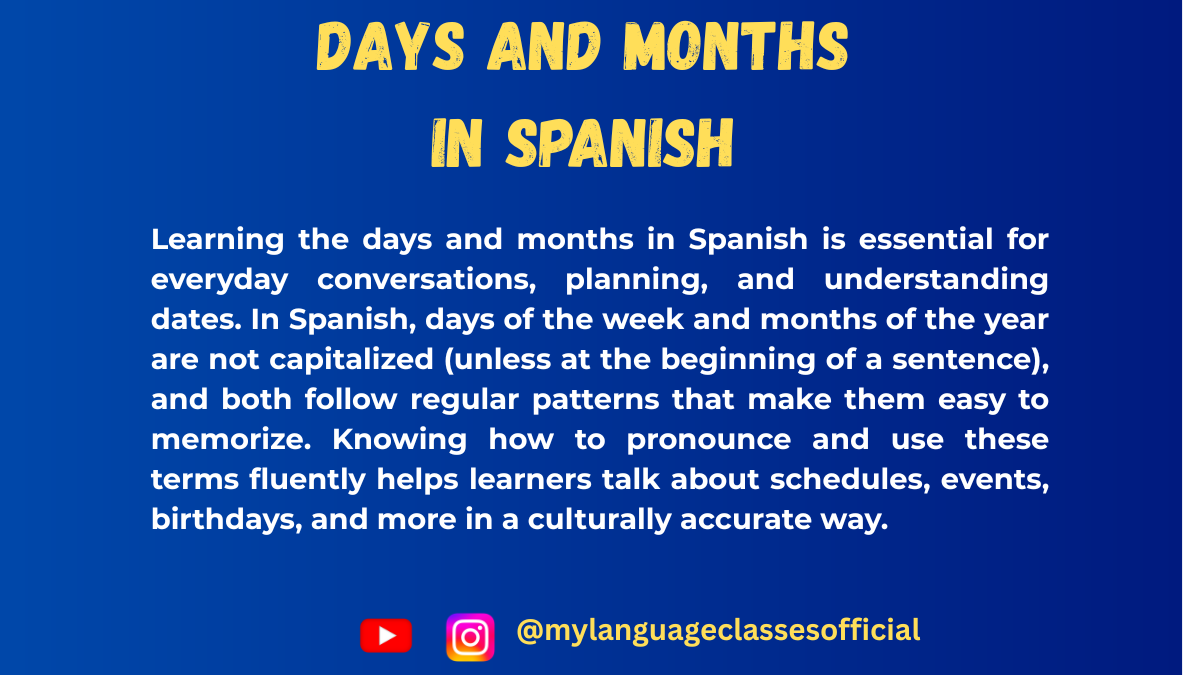Your cart is currently empty!
Tag: Learn Spanish days and months
-

Days and Months in Spanish
Learning the days of the week and months of the year in Spanish is an essential step for beginners. Not only are these words commonly used in daily conversations, but they also form the foundation for understanding dates, planning schedules, and discussing time.
Days of the Week (Los días de la semana)
Here are the days of the week in Spanish:
Spanish English Pronunciation lunes Monday LOO-nes martes Tuesday MAR-tes miércoles Wednesday mee-ÉR-co-les jueves Thursday HWE-ves viernes Friday VYER-nes sábado Saturday SÁ-ba-do domingo Sunday do-MEEN-go Key Points to Remember:
- Articles with Days of the Week:
- Days of the week in Spanish are typically preceded by the definite article el (singular) or los (plural).
Example:- El lunes voy al mercado. (On Monday, I’m going to the market.)
- Los sábados descanso. (On Saturdays, I rest.)
- When discussing habitual actions, the article is required. However, articles are omitted if you refer to a specific instance or use the verb ser (to be).
Example:- Hoy es miércoles. (Today is Wednesday.)
- Days of the week in Spanish are typically preceded by the definite article el (singular) or los (plural).
- Pluralization:
- Most days of the week have the same form for both singular and plural (e.g., el lunes → los lunes).
- Exceptions: sábado and domingo add an -s to become plural: los sábados, los domingos.
- Capitalization:
- Days of the week are not capitalized in Spanish unless they are at the beginning of a sentence.
Months of the Year (Los meses del año)
Here are the months of the year in Spanish:
Spanish English Pronunciation enero January eh-NE-ro febrero February fe-BRE-ro marzo March MAR-tho abril April ah-BREEL mayo May MA-yo junio June HOO-nyo julio July HOO-lyo agosto August ah-GOS-to septiembre September sep-TYEHM-bre octubre October oc-TOO-bre noviembre November no-VYEHM-bre diciembre December dee-TYEHM-bre Key Points to Remember:
- Articles with Months:
- Unlike days of the week, months are not usually used with articles unless they are part of a specific context.
Example:- Nací en abril. (I was born in April.)
- El marzo pasado fue lluvioso. (Last March was rainy.)
- Unlike days of the week, months are not usually used with articles unless they are part of a specific context.
- Prepositions:
- The preposition en is used to indicate a month.
Example:- Vamos de vacaciones en agosto. (We’re going on vacation in August.)
- The preposition en is used to indicate a month.
- Capitalization:
- Like the days of the week, months are also not capitalized in Spanish unless at the start of a sentence.
Cultural Notes
- Starting the Week:
- In Spanish-speaking countries, the week traditionally starts on lunes (Monday), unlike in English, where it often starts on Sunday.
- Abbreviations:
- Days of the week are commonly abbreviated in informal writing:
- L, M, X, J, V, S, D
(X is used for miércoles to avoid confusion with martes.)
- L, M, X, J, V, S, D
- Months can also be abbreviated, especially in calendars: ene., feb., mar., etc.
- Days of the week are commonly abbreviated in informal writing:
- Expressions and Idioms:
- Día de descanso: Day off (typically Sunday in many cultures).
- Fines de semana: Weekends (Saturday and Sunday).
- Un día cualquiera: Any given day.
Practical Tips for Learners
- Practice with Real-Life Scenarios:
- Try saying today’s date in Spanish:
- Hoy es lunes, 16 de diciembre de 2024.
- Practice asking and answering questions:
- ¿Qué día es hoy? (What day is today?)
- Hoy es martes. (Today is Tuesday.)
- Try saying today’s date in Spanish:
- Use Mnemonics:
- Associate each Spanish word with something familiar in your language. For example:
- lunes sounds like “lunar” (Monday named after the Moon).
- sábado sounds like “Sabbath.”
- Associate each Spanish word with something familiar in your language. For example:
- Flashcards and Apps:
- Use tools like flashcards, apps, or sticky notes to memorize days and months.
- Immersion:
- Incorporate Spanish calendars, write your plans in Spanish, and read Spanish articles to see these words in context.
By mastering these basics, you’ll gain confidence to engage in Spanish conversations about schedules, holidays, and seasons. ¡Buena suerte! (Good luck!)
If you enjoyed this lesson, be sure to check out more posts like this on my blog at My Language Classes. Don’t forget to subscribe my YouTube channel and follow me on Instagram for the latest language learning tips and lessons. Leave a comment below to share your thoughts, or ask any questions you have.
Happy learning! 😊
- Articles with Days of the Week:
